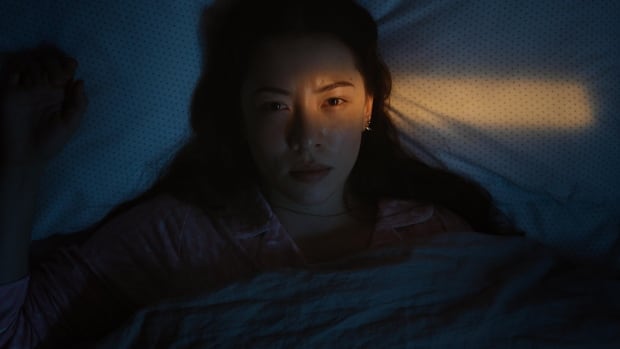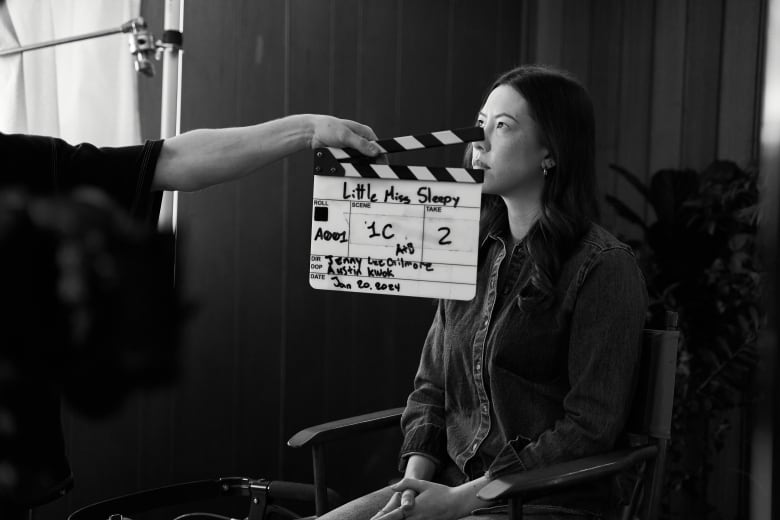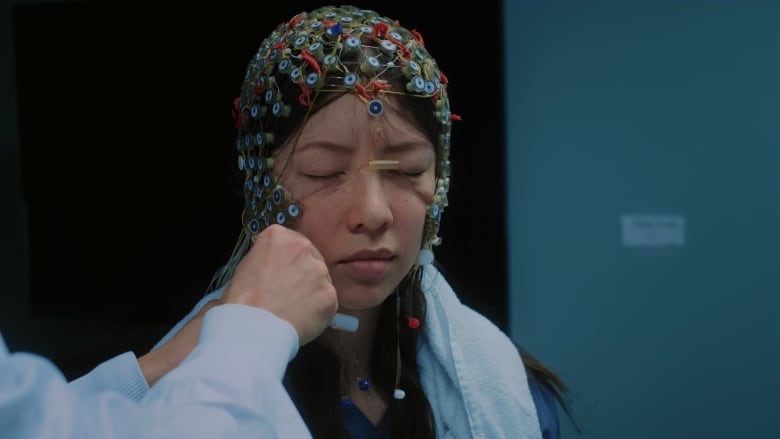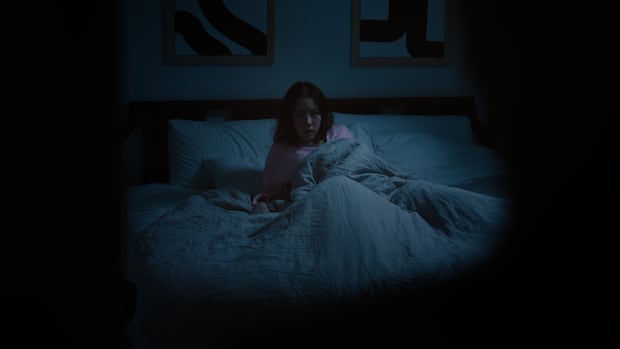
Jenny Lee-Gilmore is the director of the documentary Little Miss Sleepy. In this First Person column, Lee-Gilmore explains what it’s like to live with narcolepsy, a neurological disorder that’s misunderstood and often misdiagnosed. For more information about CBC’s First Person stories, please see the FAQ.
I knew something was really wrong when I started to fall asleep while driving.
For years, I had been tired. Really, really tired. People say that all the time, but my tiredness felt different.
When I was in school, I often had trouble staying awake in class — and not just because I found math boring. My mum would pick me up after school, and I’d fall asleep in the car before she could even ask how my day went.
No matter how much I slept, I could never shake my tiredness.
When I was around 14, I went to see my family doctor. She initially suspected I had depression and later low iron. While she may have thought I was another sad, angsty teen who needed to eat more spinach, I knew something more was going on. After taking iron supplements and seeing no improvement in my fatigue, I felt like my symptoms weren’t being taken seriously. It was incredibly frustrating.
At university, I dreaded film studies class. I knew I was going to fall asleep during those three-hour foreign films and class discussions were hard when I’d snoozed through half the movie.

I started to rely on coffee to get me through the day. Two cups quickly became four, then six. I felt like a zombie and yet, to others, I appeared pretty normal. I maintained high grades and a social life. Aside from my friends compiling a camera roll collection of me falling asleep in random places, everything seemed normal.
But when I started to fall asleep at the wheel, putting my life and the lives of others in danger, I knew I couldn’t go on living like that. Again, I told my doctor that something wasn’t right. She referred me to a sleep clinic with a long waitlist.
Finally, an explanation — and a diagnosis
During my final week at university, I got a call from the clinic. Someone hadn’t shown up, and if I could get there within two hours, I could have their spot. I packed my bags immediately.
After the sleep doctor reviewed my test results, I finally received an explanation — and a diagnosis. He told me I had Type 1 narcolepsy — a neurological condition that affects the brain’s ability to control its sleep and wake cycles.
I’d heard of narcolepsy from movies and even suspected I may have it at one point but after watching a documentary on the condition, I’d come to the conclusion I didn’t have it. After all, I didn’t pass out in the middle of the street like the people in the films.
Still, narcolepsy explained why I felt extremely exhausted no matter how much sleep I got and why I could fall asleep anywhere, anytime. The sleep doctor then asked me questions no one had asked before: How well did I sleep? Did I ever see things that weren’t there? What were my dreams like?
Ever since I was a child, I’ve experienced vivid dreams where I could feel things and even taste things, as if they were real. As I grew older, I learned to control my dreams. I could decide where I was, what happened and who was with me. The possibilities were endless. I later learned this is called lucid dreaming, and that it’s unusual. What I never thought was that it could indicate an underlying medical condition.
All of a sudden, things started to make sense, and I was eager to learn more about the condition.
I learned the key symptoms of narcolepsy are sleep hallucinations, sleep paralysis and excessive daytime sleepiness. Disrupted sleep at night is also a symptom, which is why I would wake up six to 10 times after I went to bed.
Another symptom of Type 1 narcolepsy is cataplexy (brief, sudden muscle weakness triggered by strong emotions). That’s why my knees can buckle if I laugh really hard.
Hallucinations are one of the main symptoms of narcolepsy. In the documentary Little Miss Sleepy, Jenny Lee-Gilmore describes how hers have become more vivid and more scary over time. Watch Little Miss Sleepy on CBC Gem.
A mixture of emotions
When I was finally diagnosed at 21, I was flooded with a mix of emotions: relief and happiness to have my symptoms validated, but also sadness for the girl who had struggled for years and pushed herself past the point of exhaustion.
If I had known I had narcolepsy, I would’ve had more compassion and grace for myself. Hopefully, my peers and teachers would have too. Maybe my teachers would have allowed me to walk around the classroom instead of having to sit at a desk for long periods of time (I can fall asleep if I’m not actively engaged in something). Maybe my friends would have understood why I’d cancel evening plans or not want to go out.
Then I was angry. It had been seven years since my first doctor’s visit. With my list of symptoms, it seems so obvious now that it was narcolepsy. How come it took so long to get a diagnosis? Why had no one asked me the right questions before?
Then came fear. I was told there’s currently no known cause or cure for narcolepsy. The best I could do is learn how to manage my symptoms with lifestyle changes and medication.
Fortunately, the medication changed my life immediately. I take a neurostimulant called modafinil on a daily basis. The first time I took it, I felt alive and properly awake. I couldn’t remember the last time I’d felt like that. Over time, my brain has become tolerant of the modafinil and it’s less effective, but I still see a big improvement.
The recommended lifestyle changes include getting at least eight hours of sleep, engaging in regular exercise, taking naps during the day and not driving long distances or late at night. These are all tricky for me: I work in the film industry and my hours are all over the place. This limits the jobs I can take, and it has become an increasing struggle to be able to make a living doing what I love.
No laughing matter
I don’t expect everyone to know a lot about narcolepsy, but I continue to be shocked by how many people laugh, make a joke or reference a character from a movie when I tell them about my diagnosis (common references are Rowan Atkinson’s character in Rat Race or the girl who falls asleep in her food in Deuce Bigalow).
When the only representations we see are comical extremes and inaccurate stereotypes, people can’t begin to understand the daily challenges of living with narcolepsy. This may also contribute to misdiagnosis, underdiagnosis and diminishing of the real struggles faced.
The non-profit Wake Up Narcolepsy estimates it takes an average of 10 years to be diagnosed. People with narcolepsy experience higher levels of anxiety, depression and suicidal thoughts and having a diagnosis can bring validation — and help people feel like they can seek support.
I appreciate when people acknowledge that they don’t know much about narcolepsy and ask to know more. It’s an invisible disability and no laughing matter. Sometimes, I use humour to cope, but ultimately, every single part of my life — whether I’m awake or asleep — is affected.
What does my future look like?
The reality is that I don’t know what my future looks like. There is still much to learn about narcolepsy. Medical school doesn’t devote very much time to sleep disorders, so most family physicians aren’t familiar with it. No wonder my doctor was unaware of my symptoms.
In 2023, I volunteered my brain for a scientific study about narcolepsy and made a documentary about my experience. Part of the reason why I made Little Miss Sleepy was to feel like I was doing something to help.

It wasn’t pleasant to take part in the study. I had to stop taking my medication and wasn’t allowed to drink coffee. For four exhausting days, I stayed in the basement of a hospital while doctors glued electrodes to my head, did tests and monitored my brain function. What got me through was knowing it might help with treatment or even a cure some day in the future. That made me feel great. It gave me a sense of control and hope.
Today, I’m at a place of acceptance around my narcolepsy. I no longer feel the need to keep it a secret. I’m learning to advocate for my needs and how to take care of myself. In a 24/7 world, where pushing yourself to exhaustion on minimal sleep has become a badge of honour, I’ve learned that my physical, emotional and social well-being requires guilt-free rest.
While I don’t know what my future holds, I now know how to manage my symptoms and navigate life with narcolepsy. I hope Little Miss Sleepy will raise awareness around narcolepsy and maybe help people with the condition feel less alone.
Watch Little Miss Sleepy on CBC Gem.
Do you have a compelling personal story that can bring understanding or help others? We want to hear from you. Here’s more info on how to pitch to us.




